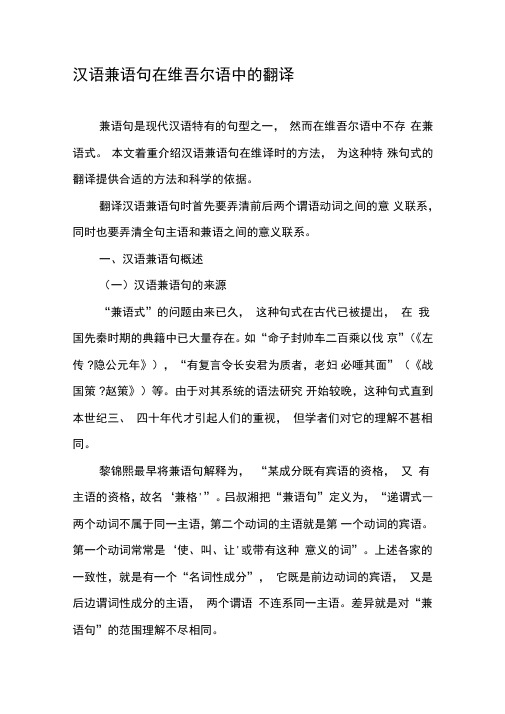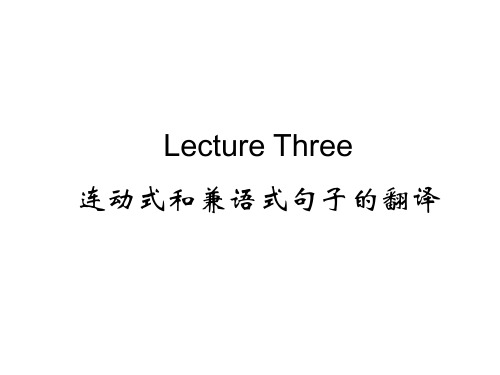201403第三次-多动句和兼语式的翻译
连动式和兼语式的译法探析

语动词 , 按原 文中的先后顺 序 , a d加以连接。例如 : 用 n
1 把 书接 过 来 摆 在 膝 盖 上 。 H o ebo n i . 他 et kt okadl d o h a
i o s lp. t n hi a
6 虚使人进 步, . 谦 骄傲使人落后 。
分析 : 在这 句话 中 , 兼语 式 的特征不是很 明显 , 但这里 的
连动式 的这两个或 两个 以上的动词 所表示 的动作 、 为 , 行 在 顺序上不能变动 。根据这一特征 , 可用如下方法进 行翻译 : ( ) 一 表示先后 关系 的连动式 通常将 几个动词 都译成 谓
语 有两个动词 , 前一动词的宾语 , 又是后一动词 的主语 , 前后 两个动词不共用一个主语 。兼语式 的基本译法有 以下几种 : ( ) 一 按英语 的 S O 主语 +谓语 +宾语 +补语 ) 型 V C( 句 把兼语 式的第二个动词转化为英语 的宾语补足语 。 A 很多情况下, . 其宾补是 由不定式充 当。
一
表示手 段 、 目的关 系的连 动式 中 , 二个动词 有时也 可 第 以用含 目的意义的介词来译 。 4他 回房 间去取钥匙 。He e t ak o iro rh e. . n c somf e y w b th ot k ( ) 些连动式 , 三 有 前一个 动作表示 后一个 动作 的方式 、 状态 , 两者形成 主从关 系。 在英译时 , 通常把后 一个 动作 用限
定 动 词 译 成 谓语 , 一 个 动作 译 成 分词 或介 词短 语 。 前
5 ] . 热烈鼓掌欢迎美国来宾 。T e e o dh A ei f hy l me e m r w c t —
c n g e t wi a n p lu e a u ss t w r l p a s . h a
汉语兼语句在维吾尔语中的翻译

汉语兼语句在维吾尔语中的翻译兼语句是现代汉语特有的句型之一,然而在维吾尔语中不存在兼语式。
本文着重介绍汉语兼语句在维译时的方法,为这种特殊句式的翻译提供合适的方法和科学的依据。
翻译汉语兼语句时首先要弄清前后两个谓语动词之间的意义联系,同时也要弄清全句主语和兼语之间的意义联系。
一、汉语兼语句概述(一)汉语兼语句的来源“兼语式”的问题由来已久,这种句式在古代已被提出,在我国先秦时期的典籍中已大量存在。
如“命子封帅车二百乘以伐京”(《左传?隐公元年》),“有复言令长安君为质者,老妇必唾其面”(《战国策?赵策》)等。
由于对其系统的语法研究开始较晚,这种句式直到本世纪三、四十年代才引起人们的重视,但学者们对它的理解不甚相同。
黎锦熙最早将兼语句解释为,“某成分既有宾语的资格,又有主语的资格,故名‘兼格'”。
吕叔湘把“兼语句”定义为,“递谓式―两个动词不属于同一主语,第二个动词的主语就是第一个动词的宾语。
第一个动词常常是‘使、叫、让'或带有这种意义的词”。
上述各家的一致性,就是有一个“名词性成分”,它既是前边动词的宾语,又是后边谓词性成分的主语,两个谓语不连系同一主语。
差异就是对“兼语句”的范围理解不尽相同。
(二)汉语兼语句的定义一个述宾短语和一个主谓短语套叠在一起,而且述宾短语中的“宾语”兼作主谓短语的“主语”,这样的短语叫作兼语短语。
由兼语短语作谓语的句子称作为兼语句。
它的基本格式是:主语一谓语1—兼语一谓语2。
它是现代汉语中比较特殊的一种动词谓语句,同时也是现代汉语中一个重要的句式。
而维语中没有和它相同或相似的形式,于是给翻译带来了一定的困难,但兼语句前后两个谓语动词之间总是总是有一定的意义联系,只要弄清兼语句前后两个谓语之间的意义联系,也就不难理解了。
二、汉语兼语句的类型及特点(一)汉语兼语句的类型1. 表示使令意义的兼语句这种兼语句的第一个动词是表示使令意义的,如:“使、让、叫、请、派、强迫”等等。
(汉英翻译)第九讲 连动式和兼语式的翻译

3. 我们应当起来捍卫真理。
We should come forward in defense of truth.
精选ppt
11
练习:翻译下列句,注意连动式谓语的译法。
1、他拉过一把椅子放在客人的后面。 2、第二天早上,他到镇上借钱买茶叶。 3、他解开大襟上的纽扣,又抓着衣角扇了几下,
站起来回家去。 4、她抱住女儿的头痛哭着。 5、她腋下夹着几本书回来了。 6、我要带着孩子到街上走走。 7、暑假里他乘火车到西安去参观。 8、他打发儿子到城里去买些二、 兼语式的译法
兼语式语句的句法特点: 谓语有两个动词,前一个动词的宾语又
是后一个动词的主语,前后两个动词不共一 个主语。
精选ppt
13
翻译方法:
一、 按英语的SVOC句型把兼语的第二个动 词转化成英语的宾语补足语。
当兼语式的第一个动词是 “使、让、叫、 请、劝、派、要求、迫使、号召、鼓励、 禁止……”等时,译成英语后,很多情况下, 其宾语补足语是有动词不定式来充当的。 如:
15
有时英语的宾语补足语也可由介词来充当。如:
1. 他迫使对方处于守势。 He drove his opponent into a defensive position.
2. 解放前环境迫使他行乞。
Before liberation circumstances forced him into begging.
精选ppt
14
1. 虚心使人进步,骄傲使人落后。 Modesty helps one to go forward, whereas conceit makes one lag behind.
2. 我们都劝他戒烟。 We all advised him to give up smoking.
特殊句式——兼语句

932016年第12期总第169期No.12. 2016Sum 169哲学文史研究作者简介:钱 琼(1989-),女,汉族,浙江宁波人,沈阳师范大学,15级在读研究生,硕士学位,主要从事课程与教学论(对外汉语)研究。
兼语句这种特殊句式由来已久,在古代汉语中就已经存在,但对它进行系统的研究却开始于现代汉语。
黄伯荣、廖序东主编的《现代汉语》(1997)把兼语句定义为:“由兼语短语充当谓语或独立成句的句子叫兼语句。
”现有的研究,有很多事从分析兼语句的定义入手,已取得了不少理论成果。
同时许多学者也对兼语句的结构和与之相类似的相关句式做了不同角度的比较研究,主要与下列相关句式进行过对比:一、兼语句和双宾语句的区别双宾语句中,以动词、动词性短语或主谓短语作远宾语时,就容易与兼语句相混淆。
它们之间的区别在于:双宾语的动词是三价动词,两个宾语之间不构成结构关系,但兼语句中 N2 和 V2之间存在结构关系。
兼语句中 V2 回答V1+N2“干什么”或“怎么样”的提问,而双宾语句回答V1+N2什么的提问。
在双宾语句中,当远宾语由动词或动词性短语做小句的谓语,它所表示的含义其实是动态的,而兼语句动词所表现的是静态的;其次,由于双宾语的V1是三价的,是可以带三个名词的,而兼语句的 V1 却只能带两个名词。
二、兼语句和连动句的区别连动句是指动词或动词短语连用充当谓语或独立成句的句子。
它所有的动词或动词短语都可以分别跟同一个主语发生主谓关系,是陈述同一主语的;兼语句则是V2和N2构成主谓关系,不与N1构成主谓关系。
由于连动句动词之间结构紧凑,几个动词之间是没有停顿的。
三、兼语句和主谓宾语句的区别:主谓宾语句是主谓短语充当宾语的句子,整个主谓短语一起充当V1的宾语,N2与主谓短语的动词不构成关系。
而兼语句的N2与V2是构成关系的。
例如“我请他来”和“我知道他来”两个句子分别是兼语句是主谓宾语句。
仔细比较能够发现两者有明显区别:(1)停顿处和可加状语的地方不同;(2)第一个动词的性质不同;(3)句子的变换式不同。
兼语句名词解释

兼语句名词解释兼语句是一种特殊的修辞格,它是前后两个谓语交错使用,兼有两种语义。
因为兼语句既可以由主语和谓语构成,也可以由主语、谓语和宾语构成,所以兼语句又叫做“三重”句。
在叙事性的文章中,为了增强表达效果,提高作品的艺术感染力,常常采用兼语句,这是一种主语与谓语倒置的修辞格。
它是指一个句子里同时出现几个并列成分,每个成分之间没有任何关系,即各说各的话。
其目的是扩大语言容量,给读者留下充分想象的余地。
这种兼语句也被称作“多重复句”或“多重层次”。
1、主谓倒置。
就是主语与谓语倒过来说,如:(1)四川军阀刘湘派兵包围成都,大肆屠杀人民,严重破坏革命力量。
( 《收回川汉铁路建筑权》)(2)整天跟着这些孩子东奔西跑,他们的父母,祖国人民怎能不操心?( 《第二次握手》)以上例句,前面的“刘湘”是主语,后面的“兵”是谓语,属于主谓倒置。
2、主宾倒置。
是主语和宾语倒过来说,如:( 1)无论哪一本书,只要读得认真,思考得深刻,都能受到教益。
( 《关于党的若干历史问题的决议》)以上例句,前面的“无论……”是主语,后面的“那一本书”是谓语,属于主宾倒置。
3、定语后置。
是定语放在谓语的前边,如:( 1)张大娘见李玉和衣衫破旧,身体瘦弱,很同情他,常常接济他。
( 《荷花淀》)以上例句中的“张大娘”是定语,后置。
3、定语后置。
就是定语放在谓语的前边,形成了倒装句。
它具有兼语句的一切特征,只是在语序上颠倒了。
4、状语后置。
是状语放在谓语的前边,形成了倒装句。
它具有兼语句的一切特征,只是在语序上颠倒了。
5、补语后置。
就是补语放在谓语的后边,形成了倒装句。
它具有兼语句的一切特征,只是在语序上颠倒了。
6、独立成分倒装。
它是把不是并列成分而是构成短语(或单句)的成分安排在前面,如:( 1)敌人出动了飞机大炮,我们只好边打边退。
( 《狼牙山五壮士》)(2)政府号召全民族一定要保卫胜利果实。
( 《打响了第一炮》)(3)夜深了,路灯亮了,银光闪闪,像一排排士兵在前边开道。
汉语兼语句的翻译

(4) 没什么, 那么你叫鲁妈进来吧。 No. well, you’d better show Mrs. Lu in. (5) 她不愿意上楼,回头你先陪她到楼上去, 叫底下人好好地伺候她睡觉。 She refuses to go upstairs. I want you to take her up to her room and tell one of the maids to see her into bed all right.
6. They regarded her as the right candidate for the National People’s Congress. 7. His sudden death made all his colleagues shocked. 8. We have a teacher who comes from England. 9. The teacher found many of the students’ compositions interesting. 10. Mother asks me to make a call home every week.
五、将主谓结构用状语从句译出
(9)老师表扬他乐于助人。
The teacher praises her because he is always ready to help.
(10)他责备儿子迟迟不回家。
He reproached his son for staying out late.
练习十五 P104
汉语兼语句的翻译
兼语句的形式
一个汉语句子的谓语有一个动宾结构和一个主 谓结构套接在一起,动宾结构中的“宾语”兼 做主谓结构中的“主语”。
汉语连动式兼语式的英译

▪ Young lady, you’d better mind your own business.
▪ 你妈妈叫你马上回去。
▪ Your mother wants you back home at once.
▪ 我们必须使房子保持整洁。 ▪ We must keep the room clean and tidy.
▪ 什么事使你这么样激动? ▪ What made you so excited?
▪ 有时还可以用名词。例:
▪ 然后根据英语的特点,将表示主从
关系的连动式里的主要动词译成英
语的谓语,将其他动词译成不定式、
分词、介词或介词短语。 ▪ 如果连动式里的几个动词只表示动作
先后关系,则按动作发生的先后, 译成几个并列的谓语动词。
第7页,此课件共35页哦
连动式的几种译法:
▪ 表示先后关系的连动式:
▪ 1)通常将几个动词都译成并列的谓语动词,按 原文中的先后顺序,用and加以连接。
▪ 这真叫我吃惊! ▪ It did surprise me! ▪ 这会使孩子们高兴的。 ▪ That will please the children.
第22页,此课件共35页哦
▪ 再如:
▪ 这暴行使全世界公众舆论感到震惊。 ▪ This outrage shocked the world opinion. ▪ 经济的腾飞使中国在国际事务中发挥着越来
▪ 我们选他为区人大代表。 ▪ We elected him a deputy to the district people
翻译中的句法处理(汉译英)

翻译下列句子
1真是太荒唐了。 2热得我满头大汗。 3你竟然喜欢他,真是有趣。 4完成这项工作我们花了五年的时间。 5大家指望那位老教授会来参加我们的晚会。 6就只剩下28美元了。 7我一见到那孤儿,总会想起他的父母。 8四月一日,会议召开了。
选择恰当的主语完成下面的翻译,每空一词:
1星期天早晨他的身体状况仍未好转。 _ _ found him still unwell. 2.我们期望在不久的将来中国人能受到更好的教育。 _ _ _ _ that the Chinese people will get a better education in the near future. 3巨大的高炉、平炉群,每天都炼出数以万吨计的钢和铁。 Every day, _ _ _ _ _ and _ are turned out here from the huge furnaces. 4以前人们认为原子是最小的元素,现在才知道原子还可以分 为原子核与电子、中子与质子。 _ used to be _ _ the smallest elements. Now, _ _ _ that atoms can be further divided into nuclei and electrons, neutrons and protons.
1. 主语必须符合英语的语言习惯和英美等国的 文化习俗
(1)热烈欢迎世界各地客商来此进一步加强合作, 建立和发展贸易关系。 Customers from various countries and regions are warmly welcome to establish and develop business contracts.
Exhibition Hall I saw a unique fashion show. The “models” were all of middle age and even old age, ranging from 42 years to 74. They wore clothes of their own designing and making, walking on a red carpet, with the accompaniment of music, stepping naturally without training, beaming shyly and yet courageously. They gradually calmed down, restored self-confidence, and began to step in harmony with one another, and became conscious of the audience.
兼语句例句

兼语句例句兼语句,也被称为双重结构、复合句式或并列复合句,是由两个或多个同等重要的句子组成的句子。
这种句子结构常用于强调、比较、转折、因果等复杂的表达方式中。
在英语中,兼语句的构成形式非常灵活,可以使用不同的连词、标点符号和词语组成。
下面将通过例句的形式来了解什么是兼语句,并掌握它的常见结构和使用方法。
1. 强调结构兼语句可以用于强调一件事情,表达强烈的感情色彩。
例如:- I saw her last night, and she was absolutely stunning. She was wearing a red dress, and her hair was tied up in a bun. 我昨晚见到她,她真是惊艳无比。
她穿着一件红色的裙子,她的头发绑成了一个丸子头。
2. 比较结构兼语句也可以用于比较两个或多个事物。
例如:- I love both pizza and pasta, but I think I prefer pizza. Both are delicious, but pizza is just more satisfying. 我喜欢比萨和意大利面,但我觉得我更喜欢比萨。
两者都很美味,但比萨更加令人满足。
3. 转折结构兼语句可以用于表达转折之意,比如一个人的行为或两件事情之间的关系。
例如:- She said she loved me, but she left me without a word. 她说她爱我,但她没有任何话就离开了我。
4. 因果结构兼语句也可以用于表达因果关系,即一个事件或行为导致了另一个事件的发生。
例如:- He didn't study for his test, so he failed it. 他没有为考试而学习,所以他就没通过。
5. 程度结构兼语句可以用于表达程度,并强调某个行为的程度。
例如:- I was so tired after running the marathon that I couldn't move for several hours. 我跑完马拉松后非常疲惫,几个小时都不能动弹。
兼语句的汉译

Page 10
10
他们想使已经存在的服务项目能够面向更广大的公众。 They want to make wider their public services that already exist. 3) make +it +形容词 + 不定式短语(从句)。 E.g.:网络使人们能更方便地和朋友交流。 Internet made it more convenient for people to communicate with their friends.
哥哥催着他干活(兼语句)
Page 13
13
①转译成形容词 我们必须使教室保持卫生清洁。
We must keep our classroom clean and tidy.
②转译成介词/介词短语 家长们迫使他们的孩子更努力地学习。 The parents forced there children to work hard. 没什么,那么你叫鲁妈进来吧。
(1)转译法 例句: 1、我只恨我自己没有早些看清你。(用副词转译) I am only sorry I did not find you out sooner. 2、我们必须使教室保持卫生清洁。(用形容词转译) We must keep our classroom clean and tidy. 3、检票员领他到座位上(介词转译)。 The usher took him to his seat. 4、他迫使对方处于守势。(介词转译) He drove his opponent into a defensive position.
Page 4
4
试比较下面两个句子
他觉得房子在摇动。(主谓作宾句) He felt the house shaking.
连动式与兼语式共存的句型浅析

连动式与兼语式共存的句型浅析
连动式语言与兼语式语言是新兴的语言理论,它们极大地丰富了语言和语言表达的形式,有助于更好地描述和沟通情感和情绪。
拥有连动式与兼语式语言(blended language)的句型,都可以用更高灵活性,更深层次的水平来施展,不论是在口头交流还是书面表达的时候,都可以改变自己的语言表现行为,有效地传达情感,让你的语言更具有表现力。
连动语言可以让你很好地表达自己的情感和想法,而兼语式则可以有效沟通理解你对对方的某些行为。
连动语言采用连续的句型格式,如“I like ____…”和“____ makes me feel ____.” 兼语式则采用多句混合的格式,如“I adore ____, ______is delightful, ______is captivating". 虽然这两种句型使用起来比较复杂,但是可以有效地生动地表达出自己的想法和感情,实现更多的情感、情绪和思想的表达和交流。
总而言之,连动式与兼语式语言极大地拓展了语言表达的形式,使表达变得更加灵活,情绪表达更自然,使沟通更加真实、有效。
201403第三次-多动句和兼语式的翻译

• 40多年来,它一直致力于弘扬中华传统文化,坚 持双语(binlingual)教育,并推行独特的书院制度 (college system),在香港教育界卓然而立。 • For more than 40 years, it has distinguished itself in the Hong Kong education arena by virtue of carrying forward traditional Chinese culture, adhering to bilingual education, and carrying out its unique college system.
• Founded in 1963, the Chinese University of Hong Kong is a research-oriented comprehensive university with a mission to combine tradition with modernity and bring together China and the west.
6. He came back home with some books under
his arm.
7. I’ll take my child to the street for a walk.
8. He went to Xi’an for a visit during the summer vocation. 9. He sent his son to town to buy some wine.
二、 兼语式的译法
兼语式语句的句法特点: 谓语有两个动词,前一个动词的宾语又 是后一个动词的主语,前后两个动词不共一
汉英翻译技巧第9章 汉语连动式和兼语式的翻译

The Sight of Father’s Back by Zhu Ziqing
I spent the first day in Nanking strolling about with some friends at their invitation, and was ferrying across the Yangtse River to Pukou the next morning and thence taking a train for Peking on the afternoon of the same day. Father said he was too busy to go and see me off at the railway station, but would ask a hotel waiter that he knew to accompany me there instead. He urged the waiter again and again to take good care of me, but still did not quite trust him. He hesitated for quite a while about what to do. As a matter of fact, nothing would matter at all because I was then twenty and had already travelled on the Tientsin-Pukou Railway a couple of times. After some wavering, he finally decided that he himself would accompany me to the station. I repeatedly tried to talk him out of it, but he only said, “Never mind! It won’t do to trust guys like those hotel boys!”
项目16 旅游翻译与汉英翻译技巧之连动句和兼语句翻译

3. 音译加意译 完全意译也有不足之处,因为没有音译,外故宫里面几个主要宫殿的名称历来有多 种译法,有的是完全音译,有的是音译和意译结合,还有的是完全意译。例如: 太和殿 Taihedian Taihedian Hall Hall of Supreme Harmony 中和殿 Zhonghedian Zhonghedian Hall Hall of Complete Harmony 保和殿 Baohedian Baohedian Hall Hall of Preserving Harmony 音意双译一般都采用专名音译、通名意译的方法,涉及历史上和传说中的人物时尤 其如此。许多山河湖海的名称也多采用此译法。如: 茅盾故居 the Former Residence of Mao Dun 杜甫草堂 Du Fu Thatched Cottage
学习任务
1. 增词法 增词法主要是对旅游资料中涉及的一些人名、地名、朝代、历史事件或典故等加以 说明。旅游宣传资料是向外国游客介绍中国的风景名胜,其中有许多民族传统文化色彩 浓厚的东西在中国妇孺皆知,但对外国游客而言却知之甚少,甚至一无所知。因此,旅
游宣传资料翻译要有针对性,增加历史事件发生的年代,名人的生卒年代,他们的身份
学习任务
一、旅游景点名称翻译 旅游景点(tourist attractions)是指以旅游及其相关活动为主要功能或主要功能之 一的空间或地域。包括风景区、文博院馆、寺庙观堂、旅游度假区、自然保护区、主题 公园、森林公园、地质公园、、文化艺术等各类旅游景点。 汉语景点的名称通常由“专有名称+通名(种类名称)”构成。专有名称是对景点的称呼, 如“太清宫”中的“太清”,“颐和园”中的“颐和”就是这两个建筑物的专有名称。 通名(种类名称)就是指判断、辨别景点类别的名词,如“太清宫”的“宫”、“颐和 园”的“园”。 当前旅游景点名称翻译存在着译名不规范、不统一的现象,这严重影响了旅游景区 形象和对外服务的质量。旅游景点名称由“专有名称”和“通名”两部分构成。
- 1、下载文档前请自行甄别文档内容的完整性,平台不提供额外的编辑、内容补充、找答案等附加服务。
- 2、"仅部分预览"的文档,不可在线预览部分如存在完整性等问题,可反馈申请退款(可完整预览的文档不适用该条件!)。
- 3、如文档侵犯您的权益,请联系客服反馈,我们会尽快为您处理(人工客服工作时间:9:00-18:30)。
第一个动词也可用分词结构来翻译,如:
他打开抽屉拿出词典来。 Opening the drawer, he took out a dictionary.
2. 有“目的”关系的连动式,翻译 时通常是 把前一个动词词翻译成谓语,而后一个动 词即表示目的的词,则用不定式译成目的 状语。
去年我和弟弟回乡去看朋友。 Last year I went home with my brother to visit our friends. 特别是在春节和婚庆期间,剪纸被用来装饰门
3. 有伴随动作的多动句,用分词。例如:
他站在门口笑。 He stood at the door, grinning. 这时植树树苗存活率高,之后长得也快,因 此清明节也是植树的好时候。 从上空来看,长城像一条蛇。 Seen from the sky, the Great Wall is like a snake. 做完了家庭作业,孩子们就回家了。 Having finished their homework, the children went home.
预测题9 --译改编简
• 香港中文大学成立于1963年,是一所研究 型综合大学,以“结合传统与现代,融汇 中国与西方”为创校使命。 • Founded in 1963, the Chinese University of Hong Kong is a research-oriented comprehensive university. • Its mission is to combine tradition with modernity and bring together China and the west.
6. He came back home with some books under
his arm.
7. I’ll take my child to the street for a walk.
8. He went to Xi’an for a visit during the summer vocation. 9. He sent his son to town to buy some wine.
二、 兼语式的译法
兼语式语句的句法特点: 谓语有两个动词,前一个动词的宾语又 是后一个动词的主语,前后两个动词不共一
个主语。
翻译方法: 1. 把兼语的第二个动词转化成英语的宾语补 足语。
当兼语式的第一个动词是 “使、让、 叫、请、劝、派、要求、迫使、号召、鼓 励、禁止……”等时,译成英语后,很多情 况下,其宾语补足语动词不定式来充当, 如:
• 体重是个大问题,因为它决定着我找男朋 友和嫁出去的可能性。 • My weight is a big problem because it determines the possibility of finding a boyfriend and getting married in the future.
窗和房间,以增加喜庆的气氛。 During the Spring Festival and wedding celebrations, in particular, paper cuttings are used to decorate doors, windows and rooms in order to enhance the joyous atmosphere.
• 40多年来,它一直致力于弘扬中华传统文化,坚 持双语(binlingual)教育,并推行独特的书院制度 (college system),在香港教育界卓然而立。 • For more than 40 years, it has distinguished itself in the Hong Kong education arena by virtue of carrying forward traditional Chinese culture, adhering to bilingual education, and carrying out its unique college system.
4. 连动式的翻译要根据英语习惯,灵活掌握, 有时也可以用其他方法 他回房间去取钥匙。 He went back to his room for the key. 人民起来反抗压迫。 The people rose against oppression.
练习:翻译下列句,注意连动式谓语的译法。
1、他拉过一把椅子放在客人的后面。 2、第二天早上,他到镇上借钱买茶叶。 3、他解开大襟上的纽扣,又抓着衣角扇了几下, 站起来回家去。 4、她抱住女儿的头痛哭着。 5、她腋下夹着几本书回来了。 6、我要带着孩子到街上走走。 7、暑假里他乘火车到西安去参观。 8、他打发儿子到城里去买些酒来。
• Founded in 1963, the Chinese University of Hong Kong is a research-oriented comprehensive university with a mission to combine tradition with modernity and bring together China and the west.
2. 英语中有大量的含有“致使、促成”意义的 动词,有时为了句子简洁有力,往往利用 这类动词来翻译。如:
这真叫我吃惊! It surprised me!
这暴行使全世界公众舆论感到震惊。
This outrage shocked the world.
4. 按照上下处理。
• The flexible credit unit system allows more freedom for students in designing their own learning. • Its multi-faceted education helps every student to give full play to their potential.
5. Informative, interesting, and of scholarly
profundity, the book contains quite a few illustrations and is worthy of perusal by theater experts, movie and TV specialists, artists, literary circles, aestheticians, sociologists and folklorist.
1. 表示先后关系的连动式, 通常将几个动词
译成并列谓语,按照原文的次序,用and
加以连接。这是翻译连动式的最基本的方 法。
他把书接过来摆在桌子上。 He took the book and laid it on the desk. 这个军官放下杯子站了起来。 The officer put down his glass and stood up.
• 其校园占地134公顷(hectare),是世界上最 美丽的校园之一。 • Its 134-hectare campus is one of the most beautiful campuses in the world .
• 灵活的学分制赋予学生更大的学习自主权。 它的多元教育有助于充分发挥每一个学生 的潜能。 • The flexible credit unit system allows students more freedom for self learning. • Its plural education helps every student to fully realize their potential.
翻译这类兼语式时,宾语补足语有时还可以 用形容词、副词或分词。如: 你妈妈叫你马上回去。 You mother wants you back home at once. 我们必须使房子保持整洁。 We must keep the room clean and tidy. 什么使你这样激动? What made you so excited? 他觉得房子在摇动。 He felt the house shaking.
Lecture Three 连动式和兼语式句子的翻译
一、连动式/多动句的翻译
汉语连动式的特点是: 两个或两个以上的动词与同一个主语发
生主谓关系。 这两个或两个以上的动词所表示的动作、 行为,在顺序上不能变动。
连动式的动词之间虽然没有关联词语,但 在意义上却有一定的关系:有的表示目的与手 段,有的表示原因与结果,有的只表示行为动 作的先后。 如果连动式里的几个动词只表示动作先后 关系,则按照动作发生的先后,翻译成几个并 列的谓语动词。 找主要动词,将其作为谓语;将其他动词 翻译成不定式、分词、介词或介词短语。
1、该国政府敦促国际社会向逃到该国的难民 提供人道主义救援。 2、安理会决定向该地区派维和部队制止冲突 升级。 3、国际奥委会选定这个城市为下界奥运会的 会址。 4、他们认为她是全国人大代表的合适人选 5、该书融学术性、知识性、趣味性于一体, 并有插图照片,可供广大戏曲、影视、美 术、文学、社会学和民俗学工作者参考。
Keys of Ex2:
1. The government appealed to the world community for providing humanitarian relief aid to the refugees who fled to its country. 2. The Security Council decided to send a peace-keeping force to prevent the escalation of conflicts in that area. 3. The International Olympic Committee has selected this city as the site for the coming Olympic Games. 4. They regard her as the right candidate for a deputy to the National Congress.
